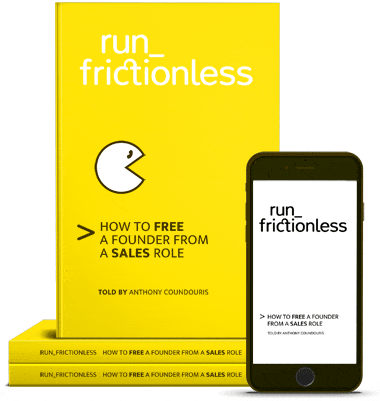
Business Model Canvas + 4Qs. A mashup of two awesome frameworks.
>
Business Model Canvas + the 4Qs. A mash-up of two awesome frameworks.
Business owners are aware of the benefits 🎓 of Business Model Canvas. A few know about the power 💪 of the 4Qs. Today we present how digital transformation consultants can mashup the Business Model Canvas and 4Qs frameworks.
Welcome, Allen Pattiselanno 🙏.
In late-2020, Allen Pattiselanno, collaborated 👏 with run_frictionless to design a mashup of the Business Model Canvas and the 4Qs frameworks. Allen is a digital transformation veteran. He runs a practice in Singapore called Digital Donkeys.
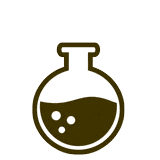
In this article, Allen Pattiselanno shares 🙌 a unique approach to digital transformation, using his own special blend of SWOT Analysis, Business Model Canvas, and 4Qs. The content in this article is based loosely on a podcast we conducted with Allen titled Business Model Canvas mashup With The 4Qs.
Listen to Allen’s explanation first-hand.

Before we kick-off, let’s introduce the 4Qs and the Business Model Canvas frameworks. That way, we are all on the same page.
BUSINESS MODEL CANVAS IN 30 SECONDS
The Business Model Canvas (BMC) is a strategic management tool to quickly and easily define and communicate a 📣 business idea or concept. It is a one-page document that works through the fundamental elements of a business or product, structuring an idea in a coherent way. The BMC gives a business a common platform to visualize their current and future business model, detect weaknesses, and test assumptions.
Not to be confused with the Business Model Navigator, the Business Model Navigator is a book written by Oliver Gassmann. This book shares these 55 recipes for success, providing practical templates to help readers build new business models from scratch and supercharge their existing models.
4Qs IN 30 SECONDS
The benefit of the 4Qs rests in how it connects staff and their processes with a 🏆 customer, through one or more Quadrants. Think of each Quadrant of the 4Qs as a window into the organization.
Each Quadrant presents an opportunity to make a transformation. The 4Qs educate staff about how their role and processes touch a customer, crucial for digital transformation to take place.
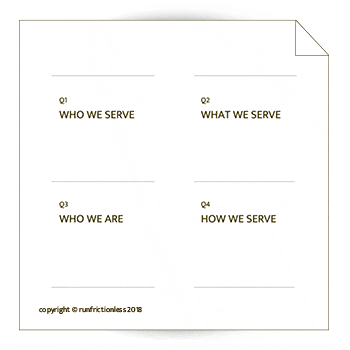
q. what frameworks other than the business model canvas do you use?

During workshops, we capture the organization’s current business model using BMC. Later I refine the BMC using various ‘lenses’ like 🔍 SWOT and the 4Qs to come up with the second BMC. For most organizations that engage us, I provide them a copy of the 4Qs playbook to continue interrogating the Business Model Canvas.
q. are there shortcomings of the business model canvas?

The Business Model Canvas has limitations. It is easy to create a current state of a business. However, when it comes to the future state, it is 👎 tedious to use. What is missing is a structure to interrogate the Business Canvas Model. I used a modified version of Mickinsey’s 7S until I discovered the 4Qs. The 4Qs provides the perfect complement to the BMC because it encourages the users to ‘fit’ or ‘play’ one Quadrant with another.

Secondly, what the business stands for is missing from the Business Model Canvas. Too often organizations get distracted and embark on a digital transformation that has nothing to do with who they are and it fails. The 4Qs address what a company stands for and calls ❤️ them ‘shared beliefs’.
q: why did you swap-out mckinsey's 7s with the 4qs?

The McKinsey 7S Framework is a management model developed by business consultants Robert H. Waterman, Jr. and Tom Peters in the 1980s.
During workshops, I used McKinsey’s 7S framework to get the project-owner to think about the type of transformation an organization needed to make. The 7S is complex and 🔔 we often got bogged down by operational details, important but not relevant for our purpose.
My clients wanted something simpler 😇 to work with during a workshop. The 4Qs was the perfect substitute. Incredibly, McKinsey’s 7s and run_frictionless 4Qs both place beliefs at the heart of the framework.
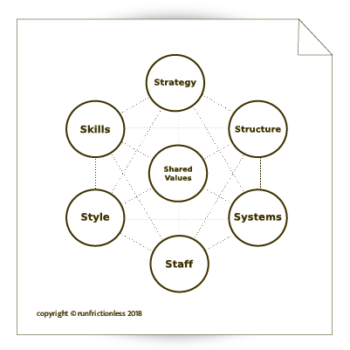
q: what is your impression of the 4qs?

The first time I read the book run_frictionless, I thought why would Anthony ask me to read a book about a sales system? Then we had a call and he linked the 4Qs to digital transformation. It was like a light bulb 💡 went off in my head. The 4Qs provides four distinct quadrants or windows into an organization:
These are key questions we ask ourselves during a digital transformation. Each Quadrant gives an emphasis on where to hunt and eliminate ‘friction’.
q: why should we mashup bmc with the 4qs?

The Business Model Canvas 👌 creates a base. I then apply a variety of ‘lenses’ to guide my client’s understanding of where they are and where they want to be. SWOT and the 4Qs are two kinds of lenses I apply. They allow me to test and refine the assumptions I made in the Business Model Canvas.
My approach suits someone like me working in a small practice with limited support. I need something comprehensive and manageable.
q: what are four best practices when using the 4qs + the business model canvas?

Yes, I can think of four ways best practices. Here they are.
01 BEST PRACTICE
Shared beliefs are a cornerstone. If you don’t know the beliefs of the organization, all the decisions ☝ made consequently are voided.
Shared beliefs are missing 💔 from the BMC framework. We need to be reminded of our shared values and that’s why I amended the BMC to include it. I suggest you use my template.
Thankfully, the 4Qs framework has an entire Quadrant dedicated to shared beliefs called Who We Are. Test if the organization has reached a Quadrant 1-3 🕹 fit with its staff, customers, and shareholders. Beliefs held by an individual are not to be confused with a shared belief. We need to test as early as possible if that belief is felt by the whole organization or just one person.
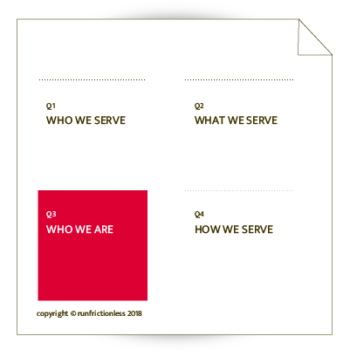
02 BEST PRACTICE
If you don’t innovate and transform significantly, the project-owner ☝will not be satisfied. Here is a litmus test I apply. If two of the following four do not change, innovation is unlikely.
DX folk can use the 4Qs to transform one of these four by striking a Quadrant 1-2 fit. A Quadrant 1-2 🕹 fit establishes the customer segment, the value proposition, and how the value proposition is produced. If an organization can strike a Quadrant 1-2 🕹 fit, revenue is generated.
As a rule of thumb, customer complaints today are a steer on who to serve tomorrow. Ask oneself how digital transformation can uncover customer complaints and map these complaints to specific customer profiles. DX folk who are able to do this can reach a Quadrant 1-2 🕹 fit faster than their competitors.
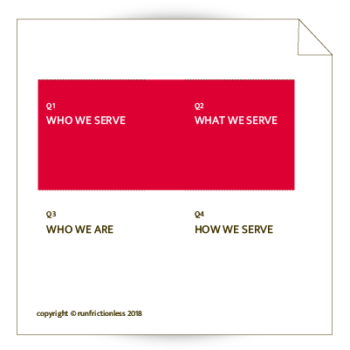
03 BEST PRACTICE
Some project-owners are overwhelmed by the information presented on a one-page Business Model Canvas. When sharing a Business Model Canvas, get the project-owner focused on these three starting points: 1 – Shared values 2 – Customer Segment 3 – Value Proposition
The same applies to the 4Qs. During an executive planning session, the 4Qs framework can get quite messy and unstructured. Try to address this by using the 4Qs playbook. The playbook goes behind the scenes to help the project-owner strike a Quadrant 1-2 fit and a Quadrant 1-3 🕹 fit. These two fits cover the three starting points mentioned above in the BMC.
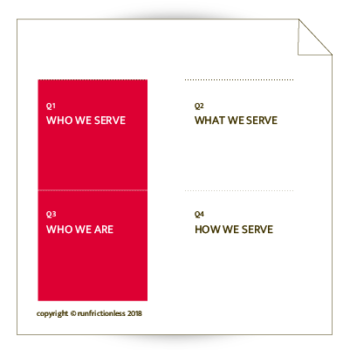
04 BEST PRACTICE
Keep old versions of the Business Model Canvas. Start a new canvas each time I make a significant change. Digital transformation is a very fluid process and truth be told, we are all 🎓 learning and adapting as we go along. Revisit old versions. Check-in and remind yourself why you made certain decisions. Were they good decisions?
The 4Qs playbook provides a useful repository of 📚 design thinking and prototyping. Observe over time how each Quadrant evolves and where friction has been reduced.

get started
using the
4Qs
SLIDESHARE RESOURCES
OTHER FREE RESOURCES
ACKNOWLEDGMENTS
Allen Pattiselanno is a digital business consultant. He has been in the industry since the early 1990’s. He has worked for organizations ranging from one-person teams to thousands of employees, giving Allen a unique perspective of how businesses should operate.
Key takeaways

run frictionless
now for only US$995





